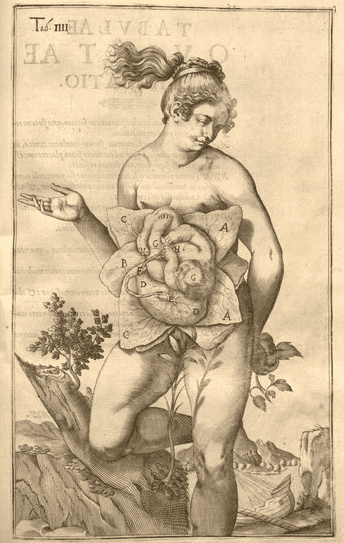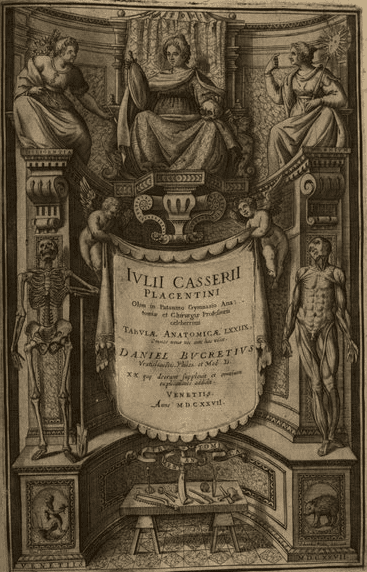Elisabeth Brander
St. Louis, Missouri, United States

Some of the most well-known images in the history of anatomy are the woodcut écorché figures that appear in Andreas Vesalius’s De humani corporis fabrica, published in 1543. Rather than lying inert on a dissection table, they stride boldly through a pastoral landscape as if still alive, showing their intricate musculature off to the reader. These beautiful illustrations made a strong impact on the field of anatomical illustration. Many of the early modern atlases published after the Fabrica, such as those by Adriaan van den Spiegel and Pietro da Cortona, also make use of heroic figures that display the intricacy of the body’s internal structure and blur the line between art and science.
One of the most noticeable aspects of these figures is the preeminence of the male form. The male body is the one displaying the building blocks of anatomy: the bones, the muscles, the nerves. In contrast, the role of the female body is to display the reproductive organs and the fetus in utero. Vesalius makes this difference in status quite clear. While the male figures are allowed to take up entire folio pages, the female body is not given an equivalent honor. She appears instead as a headless, limbless torso, her abdomen flayed open to reveal the organs within.
The only complete female cadaver to appear in the Fabrica is the one on the title page (Fig. 1). There, the body is laid out on a table as a crowd of (mostly male) spectators press close to watch as Vesalius dissects it. Historian Katharine Park notes that even here, where the female form is the focus, it is still presented as an object of spectacle, lying “supine and inert” surrounded by a crowd of men, her body positioned in a manner that draws attention to her genitals.1 This, along with the fact that the body is viewed from a distance rather than in a position of intimate contemplation, serves to emphasize the emotional and experiential distance between the reader and the cadaver.2 She is not bestowed with dignity in death.

Atlases published in the wake of Vesalius often depict gravida figures: women drawn as if they were still alive, but their torsos opened to reveal a fetus nestled inside. These images are often beautiful, sometimes even pushing into visual allegory by portraying the fetus as a flower blossoming from the mother’s body (Fig. 2). But these aesthetic qualities are still put in service of the theme that was apparent in Vesalius. The female form is not allowed to show the anatomical features that both men and women have in common; her purpose is to demonstrate the organs of reproduction.
But the anatomized female is not the only female form that appears in these atlases. Many works published in the early modern period include elaborate title pages or frontispieces that are rich in allegorical language. For knowledgeable readers, these layers of symbolism can be decoded to reveal information about both the text’s content and authorial intention. In the case of Vesalius, Park notes several ways the title page can be read. The most obvious reading is its emphasis on first-hand dissection above reliance on textual authority when studying anatomy, which is why Vesalius is shown performing the dissection himself rather than relying on a barber surgeon. Another layer of meaning is that by using a female cadaver, which was historically more difficult to acquire and held the key to the elusive “secrets of women,” Vesalius asserts his status as an anatomist supreme, with mastery over all humans. And finally, it nods to Vesalius’s ambitions regarding imperial sponsorship by including imagery that alludes to the births of Caesar and Asclepius.3

While the Fabrica’s title page puts Vesalius and the cadaver at the center of the allegory, other frontispieces lean heavily on classical imagery. Depictions of women styled like Greco-Roman goddesses were popular in early modern scientific texts. For example, we can often see Natura with her breasts bared and accompanied by a vulture (to show the dual forces of formation and corruption), Mathematica holding a compass, and Astronomia holding an astrolabe.4 Medico-anatomical publications also included this style of imagery. Depictions of the Greek goddess Hygeia (or her Roman equivalent Salus), one of the daughters of the healing deity Asclepius, tended to be popular. She can usually be identified by her staff, which has a snake wrapped around it, and she is sometimes crowned with a pentagram bearing the letters SALUS.5 In other cases, the allegorical goddess does not evoke a specific deity, but is meant to serve as a personification of the discipline itself, a distant figure looking down from above (Fig. 3).

Almost all of these allegorical figures are women. One theory is that the personifications simply reflect the gendered structure of the Romance languages, where abstract nouns such as science and nature are considered feminine.6 But historian Londa Schiebinger notes that there are other possible reasons behind this. In Christian Neoplatonism, creativity was the result of a union between the masculine and feminine principles, and that one without the other was incomplete. In the case of the allegorical frontispieces, this dynamic is artfully portrayed: the female scientific muses serve as a bridge between the secrets of nature and the male natural philosophers that uncover them.7
These allegorical goddesses might seem to occupy an exalted position in comparison to the anatomized women, but their roles are quite similar. Figures such as Anatomia might not be spread out on dissecting tables, but it is still clear that men are the ones who will bring new knowledge to the world, while women are there to support them on the journey. Sometimes this comes across as passive benevolence—for instance, in a frontispiece to Steven Blankaart’s Anatomia Reformata dated 1687, Hygeia stands at the foot of the dissection table, but the figure performing the dissection and gazing out at the reader is Blankaart. But in other instances, such as the frontispiece to the 1710 edition of Philippe Verheyen’s Corporis Humani Anatomiae, the subservience of women remains overt (Fig. 4). In that image, Nature has her robes removed by Father Time while Anatomia illuminates her with a torch. And although Anatomia is the one with pen in hand, she is not the hero(ine) of this image. The real focus is the bust of Verheyen that looms over the scene. Larger than any of the other figures and with an angel holding a laurel wreath over his head, the male anatomist is clearly in the position of power.
In early modern anatomy, men stood at the top of the hierarchy. This was not only the case in the practice of anatomy, in which men attended university lectures, had private medical practices, and published texts. It is also manifest in the allegorical language used to represent the discipline. While the beautifully rendered figures of Hygeia and Anatomia have the appearance of divine entities, there is little difference between their role and that of the anatomized female cadavers laid out on the pages. In both instances, the anatomical and allegorical woman is there as a subordinate to the male anatomist, who is the one given the honor of shepherding new understanding of the human body into the world.
References
- Katharine Park, Secrets of Women: Gender, Generation, and the Origins of Human Dissection, New York: Zone Books, 2010. 253-255.
- Park, 253.
- Park, 248-249.
- One of, if not the best source, for information on early modern allegorical imagery is Cesare Ripa’s Iconologia, first published in 1593. The second edition of 1603 included illustrations.
- While the obvious reference here is the name of the deity, it could also be linked to the Pythagorean pentagram.
- Linda Schiebinger, “Feminine Icons: The Face of Early Modern Science,” Critical Inquiry vol. 14 no.4, 1998, 672.
- vii Schiebinger, 674-675.
ELISABETH BRANDER, MA, MLS, is the Rare Book Librarian at the Bernard Becker Medical Library, Washington University in St. Louis School of Medicine. Her research interests include the history of the book, the history of anatomy, and the history of material culture in the early modern world.
Highlighted in Frontispiece Volume 14, Issue 2 – Spring 2022

Leave a Reply